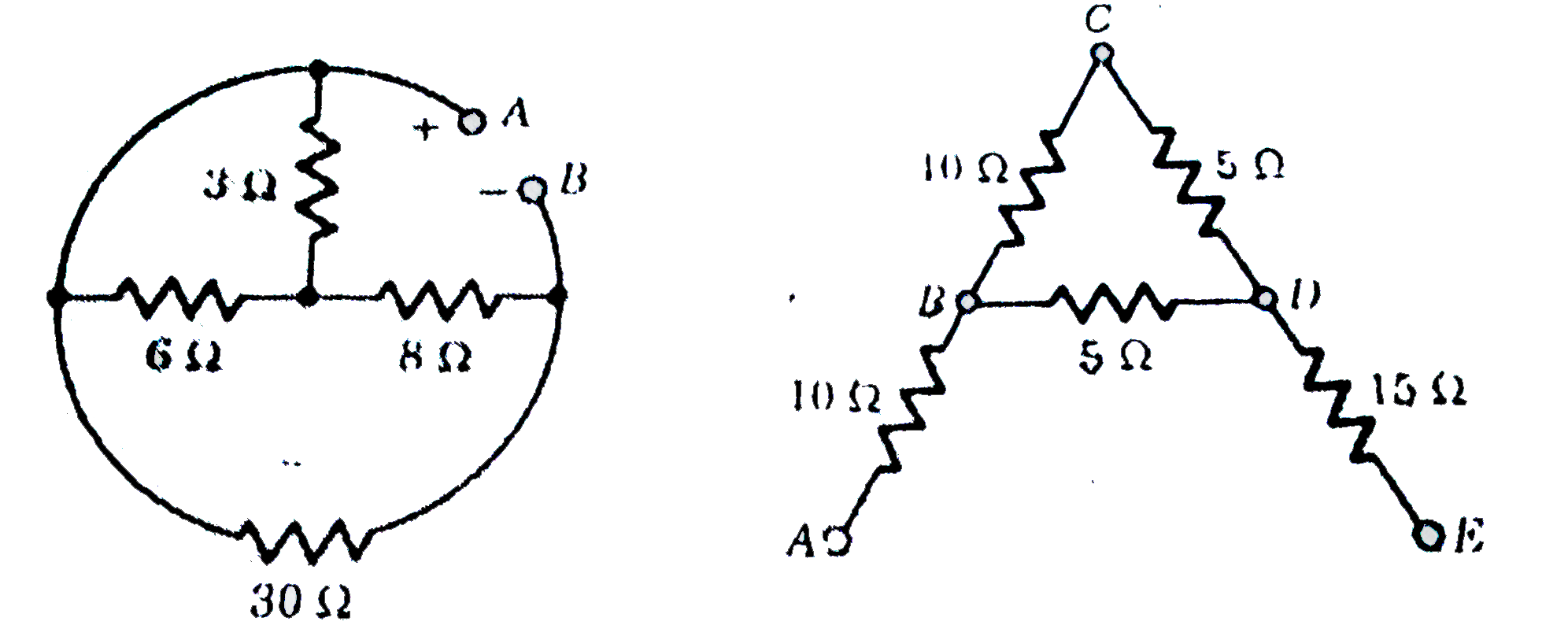Problems For Self from DHANPAT RAI & CO PHYSICS Chapter 5 CURRENT ELECTRICITY for Class 12
| Class 12 | PHYSICS |
| Chapter | CURRENT ELECTRICITY |
| DHANPAT RAI & CO PHYSICS | Problems For Self |
| Medium | English |
| Academic Year | 2023-2024 |
Question 41
A copper wire of diameter 0.16 cm is connected in series to an aluminium wire of diameter 0.25 cm. A current of 10 A is passed through them. Find (i) current density in the copper wire (ii) drift velocity of free electrons in the aluminium wire. The number of free electrons per unit volume of aluminium wire is 1029m−3.View SolutionQuestion 42
A current of 30 ampere is flowing through a wire of cross-sectional area 2mm2. Calculate the drit velocity of electrons. Assuming the temperature of the wire to be 27∘C, also calculate the rms velocity at this temperature. Which velocity is larger ? Given that Boltzman's constant =1.38×10−23JK−1, density of copper 8.9gcm−3, atomic mass of copper =63.View SolutionQuestion 43
What is the drift velcity of electrons in silver wire of length 1 m having cross-sectional area 3.14×10−6m2 and carrying a current of 10 A . Given atomic mass of silver =108, density of silver =10.5×103kgm−3, charge on electron =1.6×10−19C and Avogadro's number =6.023×1026 per kt-atom.View SolutionQuestion 44
Find the time of relaxation between collsion and free path of electrons in copper at room temperature. Given resistivity of copper=1.7×10−8Ωm, number density of electrons in copper =8.5×1028m−3, charge on electron=1.6×10−19 C, mass of electron =9.1×10−3 kg and drift velocity of free electrons=1.6×10−4ms−1View SolutionQuestion 48
An electric toaster uses nichrome for its heating element. When a negligibly small current passes through it. It resistance at room temperature (27.0∘C) is found to be 75.3Ω. When the toaster is connected to a 230V supply, the current settles, after a few seconds, to a steady value of 2.68A. What is steady temperature of the nichrome element? The temperature coefficient of resistance of nichrome averaged over the temperature range involved , 1.70×10−4C−1 View SolutionQuestion 49
A nichrome heating element connected to a 200 V supply draws an intial current of 2.2 A which settles down after a few seconds to a steady value of 2.0 A. Find the steady temperature of the heating element. The room temperature is 30∘C and the average temperature coefficient of resistance of nichrome is 1.7×10−4per∘C.View SolutionQuestion 56
(i) Three resistors 2Ω,4Ω and 5Ω are comined in parallel. What is the total resistance of the combination ? (ii) If the comnbination is connected to a battery of 20 V and negligible internal resistance, determine the current through each resistor, and the total current drawn.View SolutionQuestion 63
When a current of 0.5 A is passed through two resistances in series, the potential difference between the ends of the series arrangement is 12.5 V. On connecting them in parallel and passing a current of 1.5 A, the potential difference between their ends is 6 V. Calculate the two resistances.View SolutionQuestion 64
Two wires a and b, each of length 40 m and area of cross-section 10−7m2 , are connected in series and a potenital difference of 60 V is applied between the ends of this combined wire. Their resistances are respectively 40 and 20Ω. Determine for each wire (i) specific resistance, (ii) electric-field and (iii) current-dentsity.View SolutionQuestion 86
In the circuit shown in Fig. 4.67, the resistance of the ammeter A is negligible and that of thevoltmeter V is very high. When the switch S is open, the reading of voltmeter is 1.53 V. On closing the switch S, the reading of ammeter drops to 1.03 V. Calculate : (i) emf of the cell (ii) internal resistance of the cell (iii) value of R.
 View Solution
View SolutionQuestion 97
A 20 V battery of internal resistance 1Ω is connected to three coils of 12Ω,6Ω and 4Ω in parallel, a resistor of 5Ω and a reversed battery (emf=8 V and internal resistance =2Ω), as shown in Fig. 4.69. Calculate the current in each resistor and the terminal potential difference across each battery.View SolutionQuestion 98
Two cells connected in series have electromotive force of 1.5 V each. Their internal resistances are 0.5Ω and 0.25Ω respectively. This combination is connected to a resistance of 2.25Ω. Calculate the current flowing in the circuit and the potential differnce across the terminals of each cell.View SolutionQuestion 101
When 10 cells in series are connected to the ends of a resistance of 59Ω, the current is found to be 0.25 A, but when the same cells after being connected in parallel are joined to the ends of a 0.05Ω, the current is 25 A. Calculate the internal resistance and emf of each cell.View Solution













